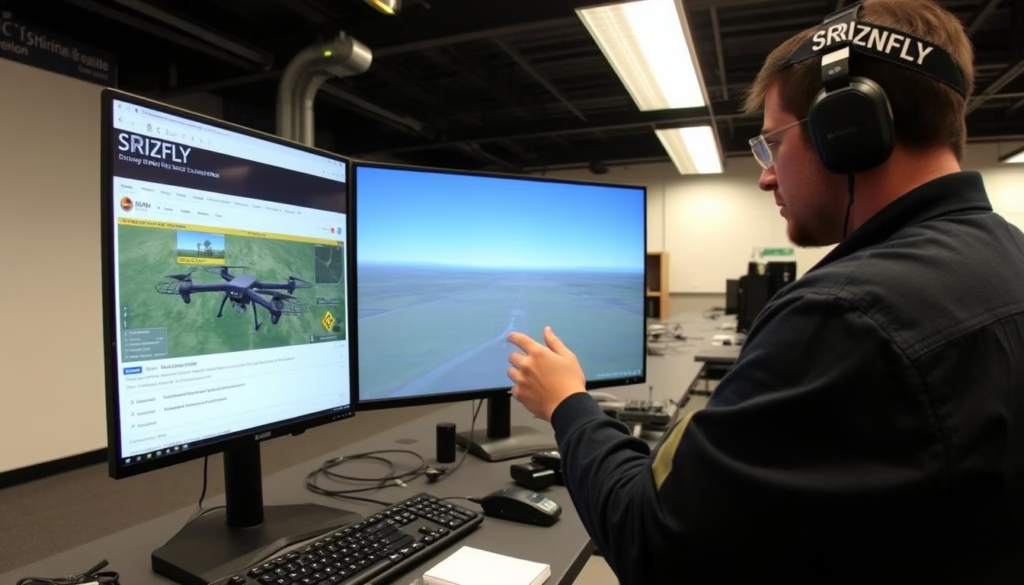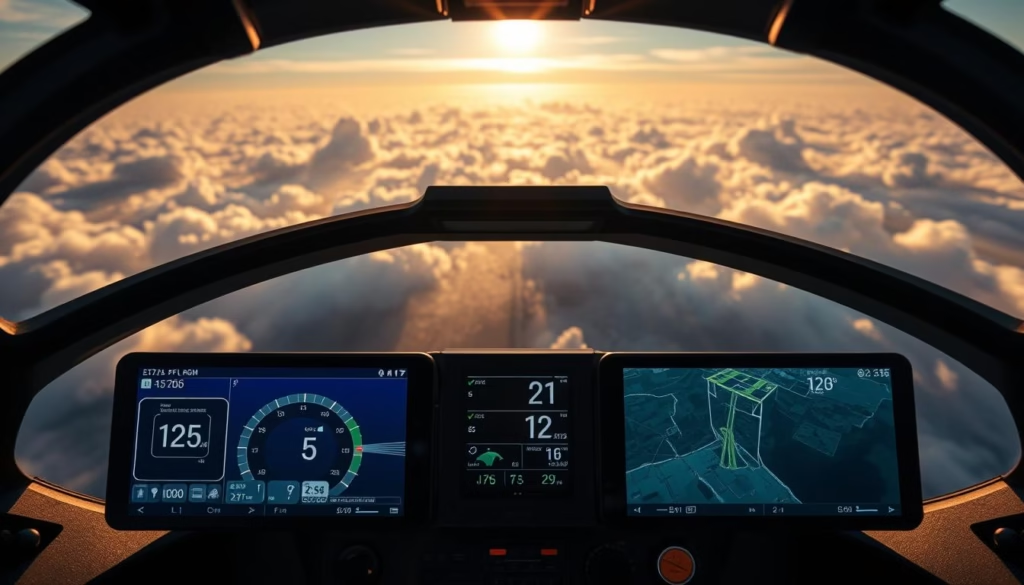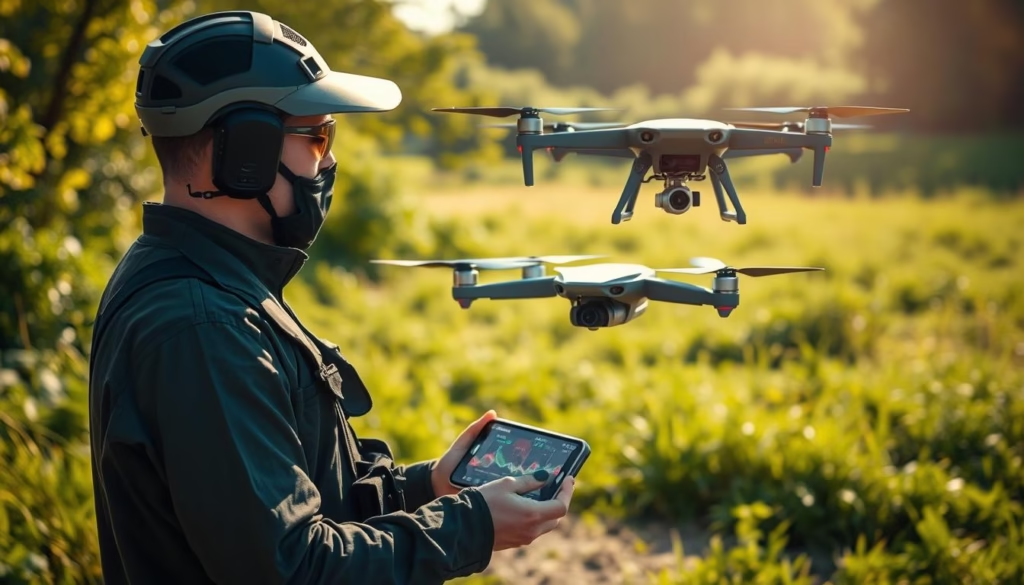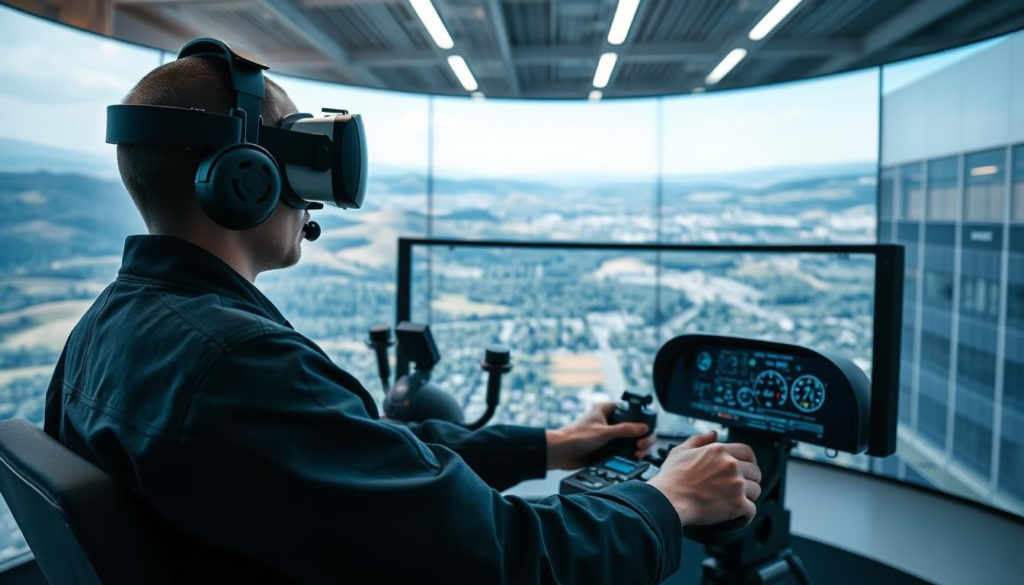The National Institute of Standards and Technology (NIST) test methods for small unmanned aircraft systems (sUAS) provide an objective measure of system capabilities and remote pilot proficiency. As the demand for drone operations grows across various industries, obtaining certification has become increasingly important.
SRIZFLY’s advanced simulator tools offer a comprehensive solution for pilots preparing for the rigorous test. Our platform provides realistic training environments that replicate actual test conditions, allowing pilots to practice and improve their skills in a risk-free environment.
With SRIZFLY’s simulation technology, you can enhance your proficiency in navigating complex airspace and improve your chances of passing the certification on your first attempt.
Key Takeaways
- Comprehensive simulator tools for drone pilot training
- Realistic training environments replicating actual test conditions
- Improved pilot proficiency in navigating complex airspace
- Risk-free environment for pilots to practice and improve skills
- Enhanced chances of passing certification on the first attempt
Understanding the NIST Drone Pilot Certification
The NIST Drone Pilot Certification is a crucial credential for drone pilots operating in the national airspace. It is analogous to getting a driver’s license for automobiles, ensuring that pilots can operate safely within the national airspace and are not a hazard to nearby ground personnel or manned aircraft.
What is NIST and Its Role in Drone Piloting
NIST, or the National Institute of Standards and Technology, plays a vital role in establishing standards for various industries, including drone piloting. By setting standardized tests, NIST ensures that drone pilots across different regions and organizations are evaluated consistently.
The Importance of Standardized Testing for Drone Pilots
Standardized testing for drone pilots is essential for ensuring safety and proficiency. Some key benefits include:
- Establishing a universal benchmark for evaluating pilot skills.
- Improving safety in drone operations by ensuring certified pilots meet minimum competency requirements.
- Providing employers and clients with confidence in a pilot’s abilities, reducing liability and operational risks.
- Allowing for objective comparison between pilots through a quantitative scoring system.
- Enabling pilots to familiarize themselves with testing protocols and scoring criteria through simulation platforms like SRIZFLY.
As drone applications continue to expand, the importance of standardized testing for remote pilots grows, distinguishing qualified pilots in a growing marketplace. By obtaining certification, pilots demonstrate their ability to operate safely within the national airspace.
The 5 Levels of NIST Drone Pilot Testing
The path to NIST drone pilot certification is structured around 5 critical levels, each designed to assess a pilot’s skills in different scenarios.
Level 1: Basic Proficiency Evaluation
At Level 1, pilots are tested on their basic flying skills, ensuring they can safely operate a drone aircraft in various conditions. This foundational level evaluates a pilot’s ability to maneuver the drone with precision.
Level 2: Open Test Lane Maneuvering
Level 2 involves navigating through an open test lane, where pilots demonstrate their ability to perform complex maneuvers in a controlled environment. This level assesses their capability to handle the drone in open spaces.
Level 3: Open Test Lane with Payload Functionality
In Level 3, pilots are required to operate the drone while carrying a payload, simulating real-world scenarios where drones are used for tasks like inspection and surveillance. This level tests the pilot’s skill in managing the drone’s payload functionality.
Level 4: Obstructed Test Lane Operations
At Level 4, the complexity increases as pilots navigate through obstructed test lanes, requiring them to avoid obstacles and maintain control of the drone. This level evaluates their ability to perform operations in challenging environments.
Level 5: Confined Space Operations
Level 5 represents the pinnacle of NIST drone pilot certification, focusing on confined test environments that demand exceptional precision and control. Pilots must navigate through tight spaces, maintaining stability and orientation, often without GPS. SRIZFLY’s simulator provides a realistic environment for pilots to practice these skills, including scenarios that mimic real-world challenges like inspecting a bucket or navigating through confined spaces.
By progressing through these 5 levels, pilots demonstrate their proficiency and readiness for complex drone operations. The test is designed to push pilots to their limits, ensuring they are capable of handling any situation that may arise during real-world missions.
Benefits of NIST Certification for Professional Drone Pilots
The benefits of NIST certification for drone pilots are multifaceted and impactful. As the drone industry continues to evolve, having a standardized measure of pilot proficiency is crucial for both career advancement and mission success.
Career Advancement Opportunities
NIST certification provides professional drone pilots with a competitive edge in the job market. By demonstrating their proficiency through a standard test, pilots can showcase their capabilities to potential employers. This certification is particularly valuable in industries where drone operations are complex and require high levels of skill, such as in infrastructure inspection, surveying, and emergency response.
As organizations increasingly adopt drone technology, the demand for certified pilots is expected to grow. By obtaining NIST certification, pilots can position themselves for career advancement opportunities and potentially higher-paying roles.
Standardized Measurement of Skills
The NIST certification process involves a rigorous test that evaluates a pilot’s skills in a controlled environment. The scoring system used in the certification process provides a clear and objective measure of a pilot’s abilities, allowing for the comparison of scores across different pilots and organizations.
This standardized measurement approach enables organizations to identify top-performing pilots and match them to missions that require specific skill levels. As a result, organizations can reduce operational risks and improve trial success rates. By tracking their scores over multiple trial attempts, pilots can also identify areas for improvement and develop a clear trajectory for their professional development.
NIST Drone Pilot Exam Simulator Tools by SRIZFLY

With SRIZFLY’s advanced simulator tools, aspiring drone pilots can prepare for the NIST certification exam with confidence. Our simulator is designed to replicate the actual test conditions, ensuring that pilots are well-prepared for the challenges they will face.
Overview of SRIZFLY's Simulation Platform
SRIZFLY’s simulation platform is engineered to provide a realistic and immersive training experience. Our simulator features realistic drone physics modeling that accurately reproduces the handling characteristics of various drone models. This allows pilots to train with equipment that matches their actual certification aircraft, enhancing their preparedness for the exam.
Key Features and Capabilities
Our NIST drone pilot exam simulator tools come equipped with a range of features designed to simulate the actual test environment. These include:
- Precise recreations of all NIST test environments, from basic open lanes to complex confined space scenarios.
- An advanced scoring system that mirrors NIST evaluation criteria, providing immediate feedback on performance.
- Variable environmental conditions, including wind effects, lighting changes, and GPS signal degradation.
- Comprehensive payload simulation capabilities for practicing camera operations and sensor management.
- Recording and playback functionality for detailed analysis of practice attempts.
By utilizing SRIZFLY’s simulator tools, drone pilots can significantly improve their test scores and enhance their overall performance.
Setting Up Your SRIZFLY Simulator Environment
Before diving into NIST drone pilot training with SRIZFLY, it’s essential to properly configure your simulator environment. This step ensures that you can focus on mastering the skills required for certification without technical hiccups.
Hardware Requirements
To use the SRIZFLY simulator effectively, your system must meet specific hardware requirements. Our software is designed to be compatible with a range of configurations, but for optimal performance, we recommend a system with a dedicated graphics card and sufficient RAM.
Software Installation and Configuration
The installation process for SRIZFLY’s drone simulator has been streamlined for simplicity. A step-by-step wizard guides you through each stage of setup and initial configuration. Our software automatically detects connected controllers and peripherals, configuring them with optimal default settings.
Some key features of the SRIZFLY simulator setup include:
- A streamlined installation process guided by a step-by-step wizard.
- Automatic detection and configuration of connected controllers and peripherals.
- Comprehensive configuration options for adjusting control sensitivity, camera behavior, and flight characteristics to match the specific drone models used in NIST certification.
- Regular software updates that incorporate the latest NIST testing standards, ensuring your training always aligns with current certification protocols.
- Offline mode capabilities, allowing pilots to train without an internet connection once the initial setup and verification process is complete.
Mastering Level 5 Confined Space Operations
Mastering Level 5 Confined Space Operations is a critical step for drone pilots seeking NIST certification. This advanced level requires pilots to navigate and maneuver their drones in highly confined spaces, simulating real-world scenarios such as industrial equipment inspection or disaster site assessment.
Understanding Dual Bucket Alignments
The dual bucket alignments are a crucial aspect of Level 5 training, guiding remote pilots through a series of 10 positions, orientations, and perches within both standard test lanes and operational scenarios. This training module is embedded with scoring tasks that result in quantitative scores up to 100 points, facilitating measurement, tracking, and comparison across different aircraft and/or remote pilots. By mastering dual bucket alignments, pilots can improve their drone control and precision, essential for achieving high scores in the test.
Practicing the Five Test Types: Perch, Wall, Ground, Alley, and Post
Level 5 certification involves five test types with increasing difficulty: Perch, Wall, Ground, Alley, and Post. SRIZFLY’s simulator provides dedicated training modules for each test type, allowing pilots to master individual challenges before combining them in full certification sequences. The Perch test evaluates a pilot’s ability to position their drone on elevated surfaces with precision, while the Alley and Post tests represent the most demanding scenarios, requiring pilots to navigate and maintain position in highly confined spaces. By practicing these tests, pilots can enhance their flight paths and overall performance, leading to better scores in the trial.
To excel in these tests, pilots must develop their skills in navigating complex environments. SRIZFLY’s simulator is designed to help pilots achieve this by providing a realistic and immersive training experience. With our simulator, you can practice and perfect your drone piloting skills, ensuring you’re well-prepared for the actual test.
Scoring System and Performance Metrics
Understanding the scoring system is crucial for drone pilots aiming to pass the NIST certification test. The results of different tests measure each pilot’s strengths and weaknesses on individual aircraft, leading to a more focused training plan for improvement.
How NIST Tests Are Scored
The NIST Drone Pilot Exam scoring system evaluates pilots based on their performance in various test types and maneuvers. SRIZFLY’s simulator provides comprehensive performance analytics that break down scores by test type, maneuver category, and specific skill components. This detailed analysis helps identify precise areas for improvement.
Interpreting Your Simulation Results
Our simulator offers several key features to help you understand your performance:
- Benchmarking capabilities compare your performance against industry averages, helping you understand how your skills measure against certification standards and other pilots.
- Detailed error analysis identifies patterns in performance deficiencies, such as consistent drift in specific directions or difficulties with particular alignment types.
- Time-based metrics track efficiency improvements, showing how your speed-to-completion evolves while maintaining or improving accuracy scores—a key indicator of developing proficiency.
- Customized training recommendations are generated based on your performance data, suggesting specific practice exercises targeted at your identified weakness areas.

By leveraging these features, you can refine your skills and improve your test scores. SRIZFLY’s progressive difficulty system automatically adjusts challenge levels based on your performance, ensuring you’re always training at the optimal difficulty level to maximize skill development.
Practical Training Scenarios in SRIZFLY Simulator
SRIZFLY’s simulator tools offer a range of practical training scenarios to prepare drone pilots for real-world challenges. These scenarios are designed to simulate complex operations and enhance the skills of pilots in a controlled environment.
Collapsed Structure Search and Inspection
The collapsed structure search and inspection scenario is a critical training exercise. It simulates the challenges faced by drone pilots in search and rescue missions. Pilots must navigate through debris and inspect damaged structures, requiring precise flight control and situational awareness.
Subway Terrorist Attack Scenario
The subway terrorist attack scenario is another complex training exercise provided by SRIZFLY. It simulates a tunnel environment with multiple DC Metro railcars, where one railcar is on its side, almost blocking the tunnel. The scenario includes survivors and suspicious packages, requiring pilots to efficiently locate and identify threats while maintaining situational awareness.
- Simulates confined tunnel systems with limited lighting and complex obstacles.
- Recreates challenges of navigating around damaged railcars.
- Incorporates realistic radio communication degradation effects.
- Simulates challenging contrast conditions found in tunnel environments.
- Evaluates a pilot’s ability to efficiently locate and identify survivors and threats.
- Provides detailed performance metrics specific to the scenario.
Advanced Techniques for Improving Your NIST Test Scores
The key to acing the NIST drone pilot exam lies in mastering advanced techniques through SRIZFLY’s simulator. To achieve this, drone pilots must focus on enhancing their skills in critical areas.
Mastering Visual Acuity Challenges
Mastering visual acuity challenges is crucial for success in the NIST drone pilot exam. SRIZFLY’s simulator includes specialized training exercises that focus on maintaining orientation awareness, even when visual references are limited. This training is vital for confined space operations, where pilots must navigate through complex environments with precision.
- Our platform provides real-time feedback on proximity to obstacles, allowing pilots to adjust their maneuvers accordingly.
- The simulator’s advanced physics modeling accurately recreates complex airflow dynamics, enhancing pilot preparedness.
Perfecting Maneuvering in Confined Spaces
Perfecting maneuvering in confined spaces is another critical aspect of the NIST drone pilot exam. SRIZFLY’s simulator features graduated confined space challenges that help pilots develop the precise control inputs needed for successful navigation.
| Feature | Description | Advantage |
|---|---|---|
| Graduated Confined Space Challenges | Systematic development of precise control inputs | Improved navigation in restricted environments |
| Specialized Training Exercises | Focus on maintaining orientation awareness | Enhanced performance in confined space operations |
| Real-time Feedback | Proximity to obstacles with customizable safety margins | Reduced risk of collisions and improved pilot confidence |
Transitioning from Simulator to Real-World Testing
SRIZFLY’s simulator training is designed to bridge the gap between simulated and real-world NIST drone testing scenarios. As drone pilots progress from simulated environments to actual NIST testing, they must adapt their skills to real-world conditions. Our simulator includes targeted training modules addressing the most common challenges faced by pilots during NIST certification.
Applying Simulator Skills to Physical Test Lanes
The skills acquired through SRIZFLY’s simulator training are directly applicable to physical NIST test lanes. Our platform provides specific strategies for managing test anxiety, including simulation of time pressure and evaluation conditions. This prepares drone pilots for the actual test process, helping them manage their time effectively during the test.
Common Challenges and How to Overcome Them
Despite thorough simulator training, drone pilots may face challenges during real-world testing. SRIZFLY’s training scenarios incorporate equipment troubleshooting simulations, helping pilots develop quick response protocols for common technical issues. Our platform also offers environmental variation training, preparing pilots for unexpected conditions such as changing light levels or wind gusts.
To further enhance the transition from simulator to real-world testing, consider the following key aspects:
- Specialized practice for the transition between different test elements to maintain precision and save time.
- Guidance on energy management and battery conservation techniques to ensure pilots can complete full certification sequences without performance degradation.

By focusing on these areas, SRIZFLY’s simulator training enables remote pilots to confidently transition to real-world NIST testing, improving their chances of success in the certification test process.
| Training Aspect | Description | Benefit |
|---|---|---|
| Simulator Training | Targeted modules for NIST certification challenges | Improved readiness for real-world testing |
| Test Anxiety Management | Simulation of time pressure and evaluation conditions | Enhanced confidence during actual tests |
| Equipment Troubleshooting | Simulations for common technical issues | Quick response protocols for technical issues |
Preparing for Certification Day
With SRIZFLY’s simulator tools, you’re well on your way to acing the NIST certification test. Our comprehensive preparation resources ensure you’re ready for the challenges ahead.
What to Expect During Official NIST Testing
During the official NIST testing, you’ll be evaluated on your drone piloting skills in a controlled environment. Expect a thorough assessment of your ability to navigate through various test lanes, including confined spaces and obstacle courses, ensuring safety and precision.
Pre-Test Checklist
SRIZFLY’s simulator includes a comprehensive pre-test checklist generator that creates customized preparation lists based on your drone model and certification level. This ensures you’re fully prepared for the test process, covering aspects such as equipment preparation, knowledge review, and physical and mental readiness.
- Equipment preparation: battery management, firmware updates, and hardware inspections.
- Knowledge review: critical regulations, airspace classifications, and emergency procedures.
- Physical and mental readiness: proper rest, nutrition, and stress management techniques.
By following SRIZFLY’s structured preparation protocol, remote pilots can optimize their performance and confidently navigate the airspace during the certification test.
Conclusion
Achieving success in the NIST drone pilot exam requires the right training tools – SRIZFLY’s simulator delivers. Our comprehensive simulator tools provide drone pilots with the exact skills and knowledge needed for certification success. By addressing every aspect of the NIST certification process, from basic flight skills to advanced confined space operations in complex airspace, SRIZFLY ensures complete preparation for all test requirements.
With SRIZFLY’s simulator, pilots benefit from a data-driven training approach, allowing for efficient progress toward pilot certification readiness. By choosing SRIZFLY, you’re investing in a proven system that has helped thousands achieve their professional goals.
FAQ
What is the purpose of the NIST certification for remote pilots?
The NIST certification is designed to ensure that remote pilots have the necessary skills and proficiency to operate safely and efficiently in various environments.
How can SRIZFLY simulator tools help me prepare for the NIST certification test?
SRIZFLY simulator tools provide a realistic and immersive training experience, allowing you to practice and master the skills required for the NIST certification test, including maneuvering in confined spaces and operating with payload functionality.
What are the different levels of NIST testing, and what do they entail?
The NIST testing has five levels, ranging from basic proficiency evaluation to confined space operations, each with its unique challenges and requirements, such as navigating through obstructed test lanes and performing precise maneuvers.
How are NIST tests scored, and what are the key performance metrics?
NIST tests are scored based on a combination of factors, including time, accuracy, and safety, with a focus on evaluating a remote pilot’s ability to operate efficiently and effectively in various scenarios.
Can I use SRIZFLY simulator tools to practice specific scenarios, such as emergency response or infrastructure inspection?
Yes, SRIZFLY simulator tools offer a range of practical training scenarios, including collapsed structure search and inspection, and subway terrorist attack response, to help you prepare for real-world operations.
How can I apply the skills I learn in the SRIZFLY simulator to real-world testing?
The SRIZFLY simulator is designed to mimic real-world conditions, allowing you to develop the skills and muscle memory needed to succeed in physical test lanes and real-world operations.
What are the benefits of achieving NIST certification for my career as a remote pilot?
Achieving NIST certification demonstrates your proficiency and expertise, opening up career advancement opportunities and providing a standardized measurement of your skills.
How do I get started with using SRIZFLY simulator tools to prepare for the NIST certification test?
To get started, simply set up your SRIZFLY simulator environment by meeting the hardware requirements and installing the software, then begin practicing with the various training scenarios and test lanes.



